Trangia: The Ultimate Cooking System
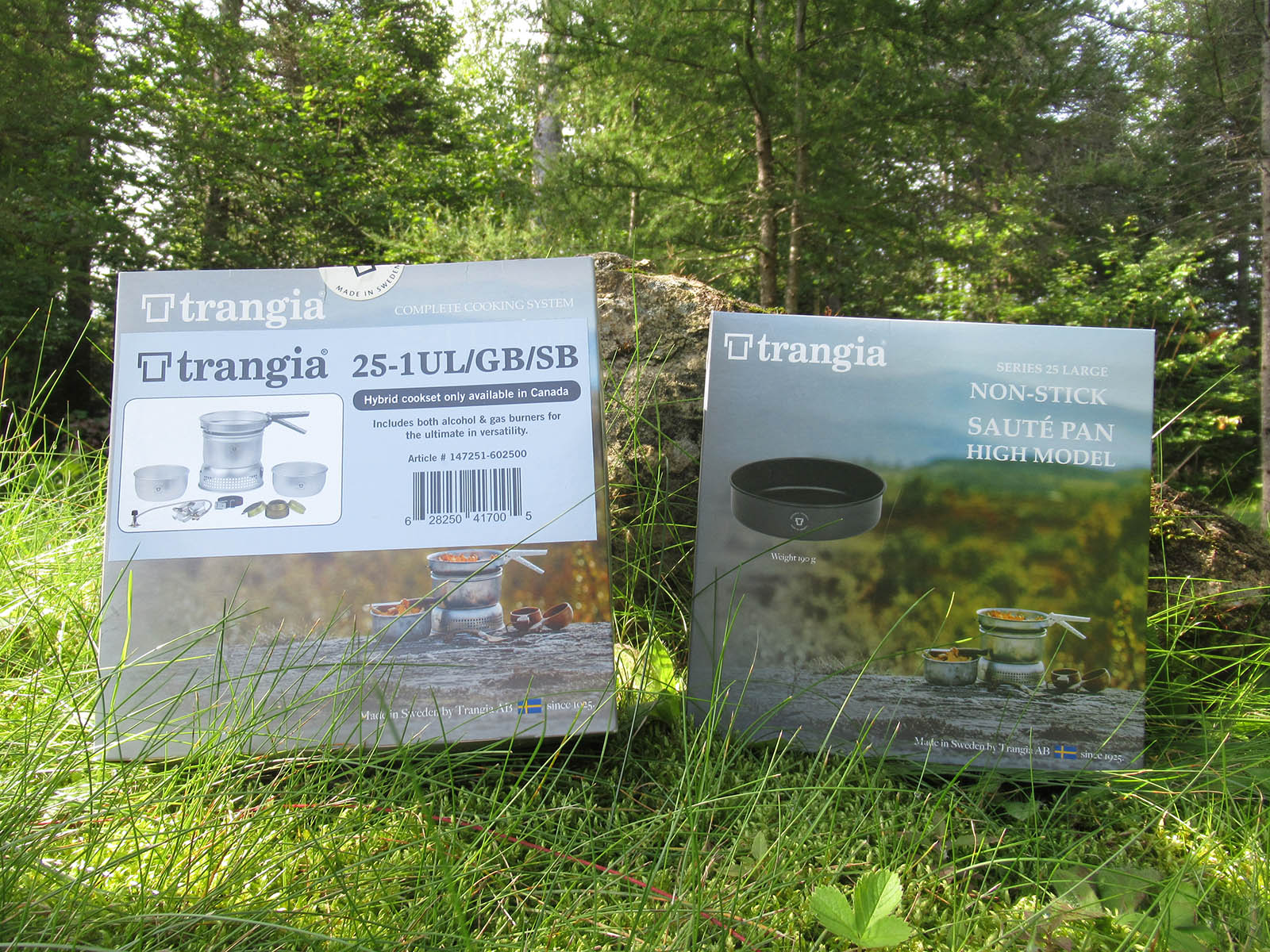
The Trangia 25 series Hybrid cooking set and high-sided saute non-stick pan, sent to me for review. Trangia’s 25-1UL/GB/SB has both gas burner (GB) and spirit burner (SB) capabilities.
Ultimate? Really?
Saying that Trangia cook sets are the ultimate cooking systems is quite the statement - to me however, they absolutely are. Their practicality and adaptability is unmatched in the world of outdoor cookwear and this is very unique. I really don’t know of any other stove system on the market featuring the capability to accommodate for such a wide variety of different types of fuel and to switch back and forth quite effortlessly. In addition to this, Trangia also offers its customers the ability to personalize and upgrade their cooking set, depending on individual needs and material preferences. This stove and burner combo, as well as the 27 series Trangia I’ve had before, has more than proven its functionality when meal prepping on a campfire was not preferred, legal or even possible.
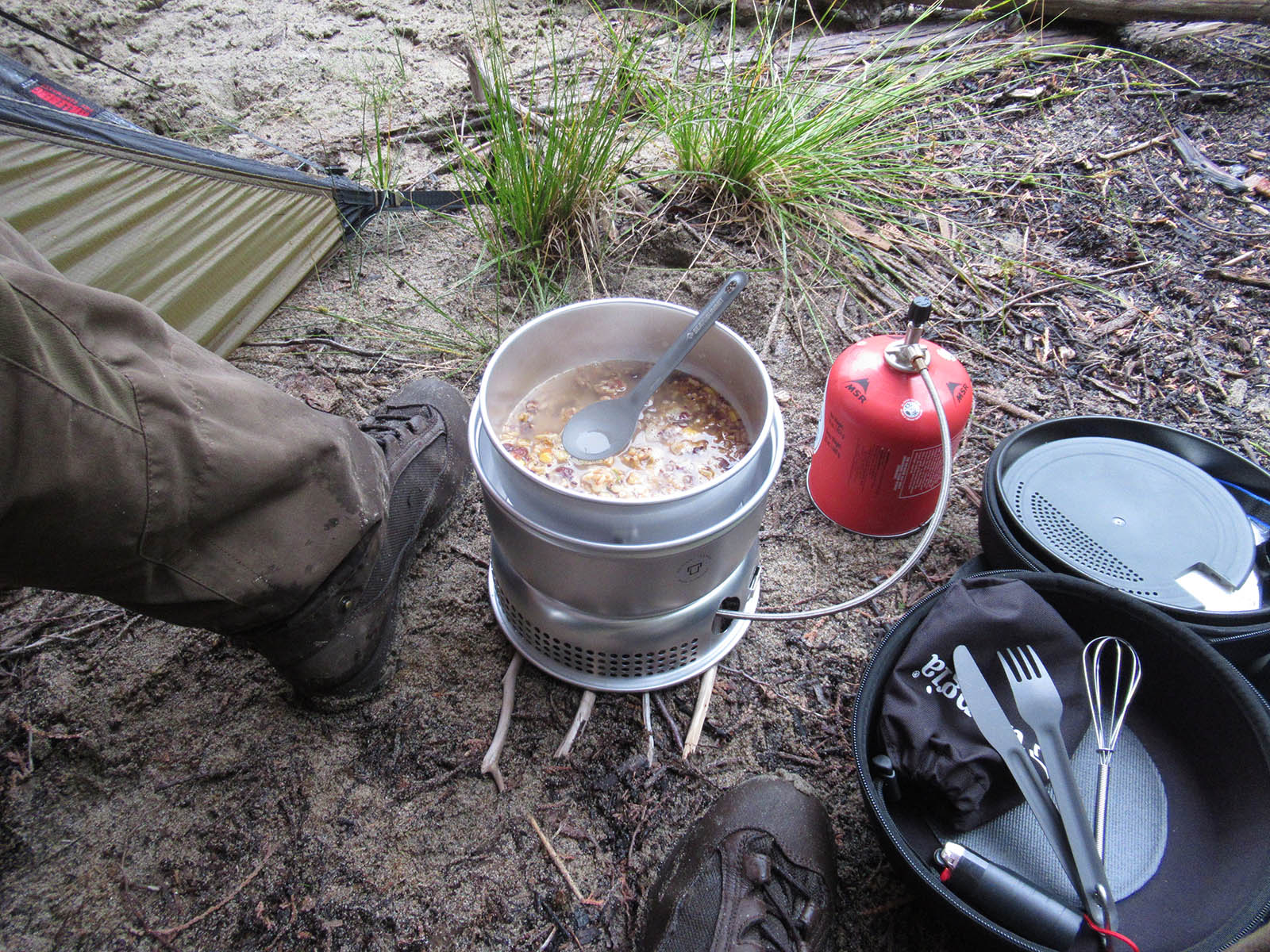
Making dinner using the Trangia gas burner unit after a long and damp day on the water. Sometimes its nice to quickly get a hot meal and drink into you without having to gather wood and start a fire.
The Swedish company Trangia AB has been around since 1925 and they essentially started out selling household cookware. In response to an increased demand for recreational camping equipment following a change in national labor laws (“Annual Leave Act”), a prototype outdoor cooking system was introduced in 1951. This system has since evolved into the different Trangia cooking sets we have available today, but remains very similar to the original - in fact current Trangia kits are interoperable with kits made as far back as the 1960's.
The components of the earliest sets, referred to as the Trangia Storm Cooker Model 25, used to be completely made from uncoated aluminum with a brass burner unit for fuel alcohol (methylated spirit). Currently, a more advanced lightweight aluminum alloy is used as the base manufacturing material, combined with other metals, processes, or applied coatings. This provides customers with 4 key options to choose from in respect to materials and coatings for pots and pans.
These 4 material options are:
1) Ultra Light (UL) Aluminum Alloy
2) Non-Stick (NS) Teflon Coated Aluminum Alloy
3) Hard Anodized (HA) Aluminum Alloy with Anodized Surface
4) Duossal 2.0 (DS) Stainless Steel/Aluminum Alloy Laminate
Both the upper and lower windscreens are available in UL, HA and NS. The Trangia kettles and mess tins are only available in UL.
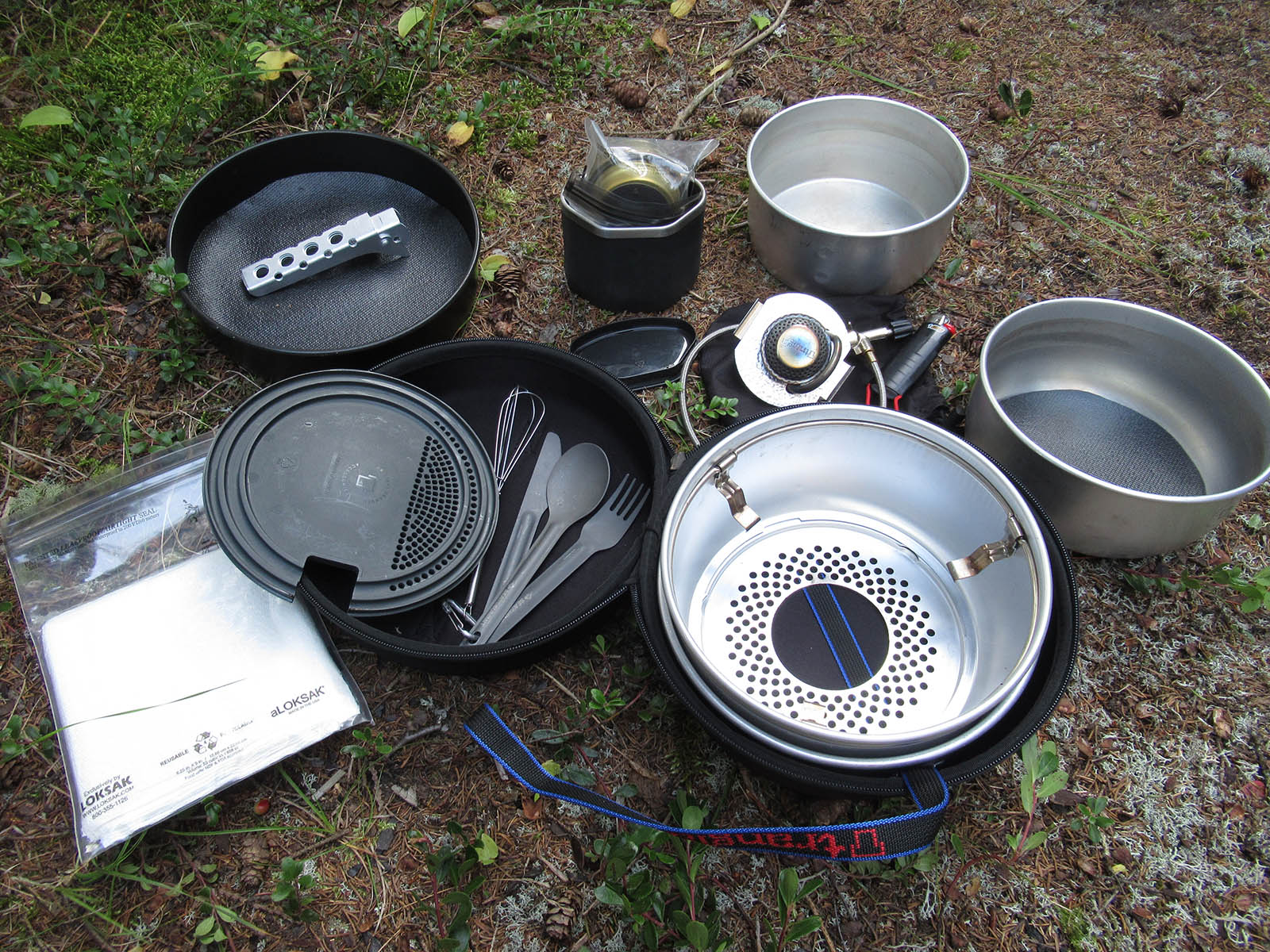
The picture above details how I set up the Trangia 25 series cook set for a 2 week river trip in northern Ontario. The larger 25 series pots made it possible to create an “all in one” personal cooking kit without compromising my ability to cook or boil for all 3 of us.
Cookset Sizes
Trangia cooking sets are available in two sizes. The smaller 27 series features an 18 cm frying pan with two 1 litre pots, also referred to as saucepans. The larger 25 series has a 22 cm frying pan with a 1.5 litre and a 1.75 litre pot. The 27 series is suitable for 1 to 2 people while the 25 series can accommodate up to 3 and 4 people.
The half litre volume difference between the inner saucepans of the new 25 series versus my old 27 series, created quite a bit of extra room actually. I really liked this because it offered the opportunity to create a personal “all in one” cooking set while also maintaining the ability to use the bigger saucepans to heat a meal or boil water for all three of us at once. This extra space also allowed me to store the drop-in gas burner safely inside the set, keeping it both readily available and well protected. It made the whole kit a bit heavier but I had everything I needed to cook, besides the fuel, at my fingertips in one self-contained package.
Although many options and combinations are made available, in essence you get an upper and lower windshield, two pots, a pan, a grip handle, an alcohol burner, the option to include a kettle if desired and a strap to keep it all together. Trangia created a reliable, lightweight and straightforward cooking system which is very stable and wind resistant while in use. It has very minimal moving parts and the ability to replace, upgrade or add functional components.
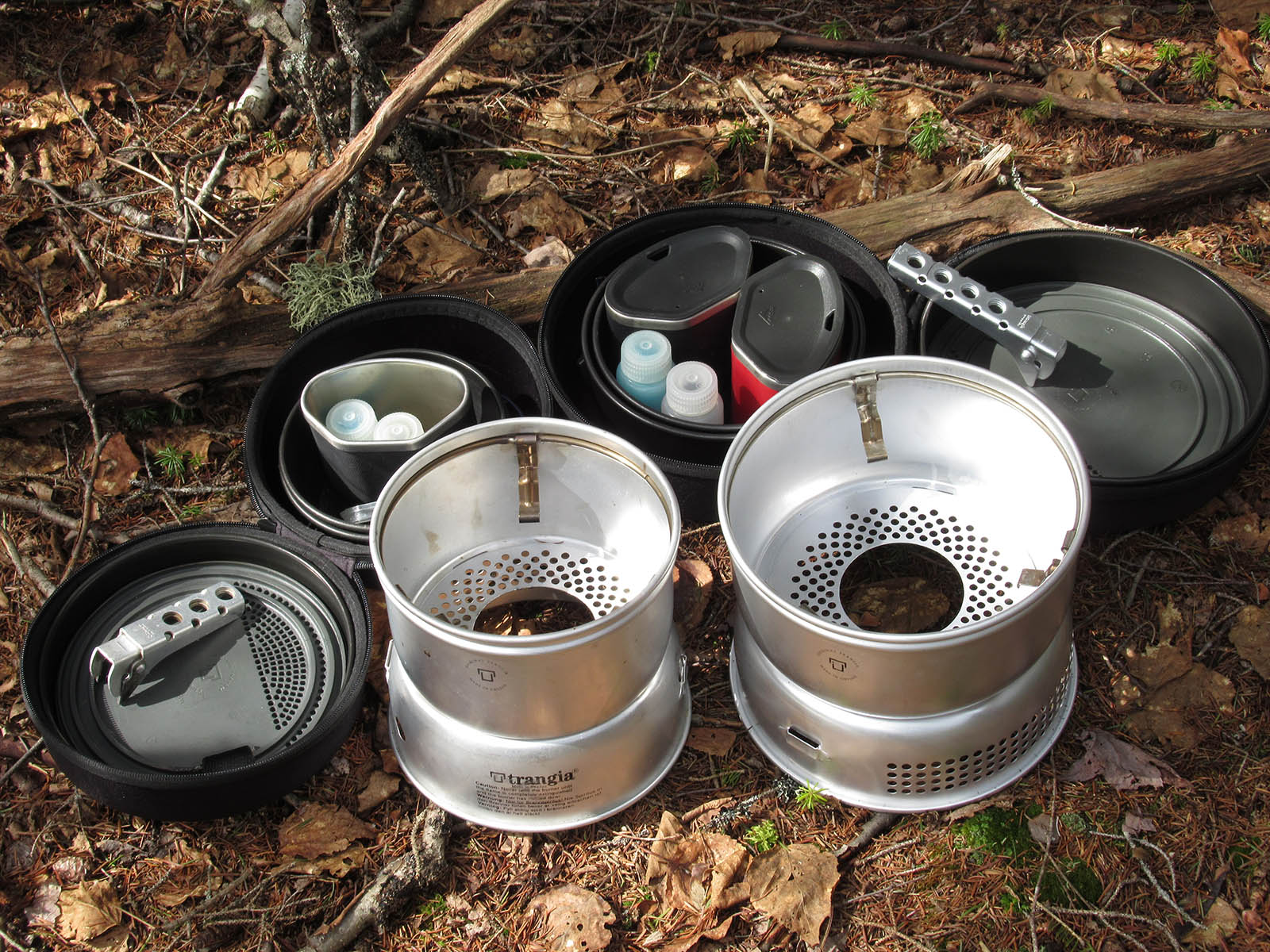
My older 27 series set next to the new 25 series. Trangia offers stable, straightforward, lightweight and reliable cooking sets which are easily adaptable to burn other fuels then just spirits.
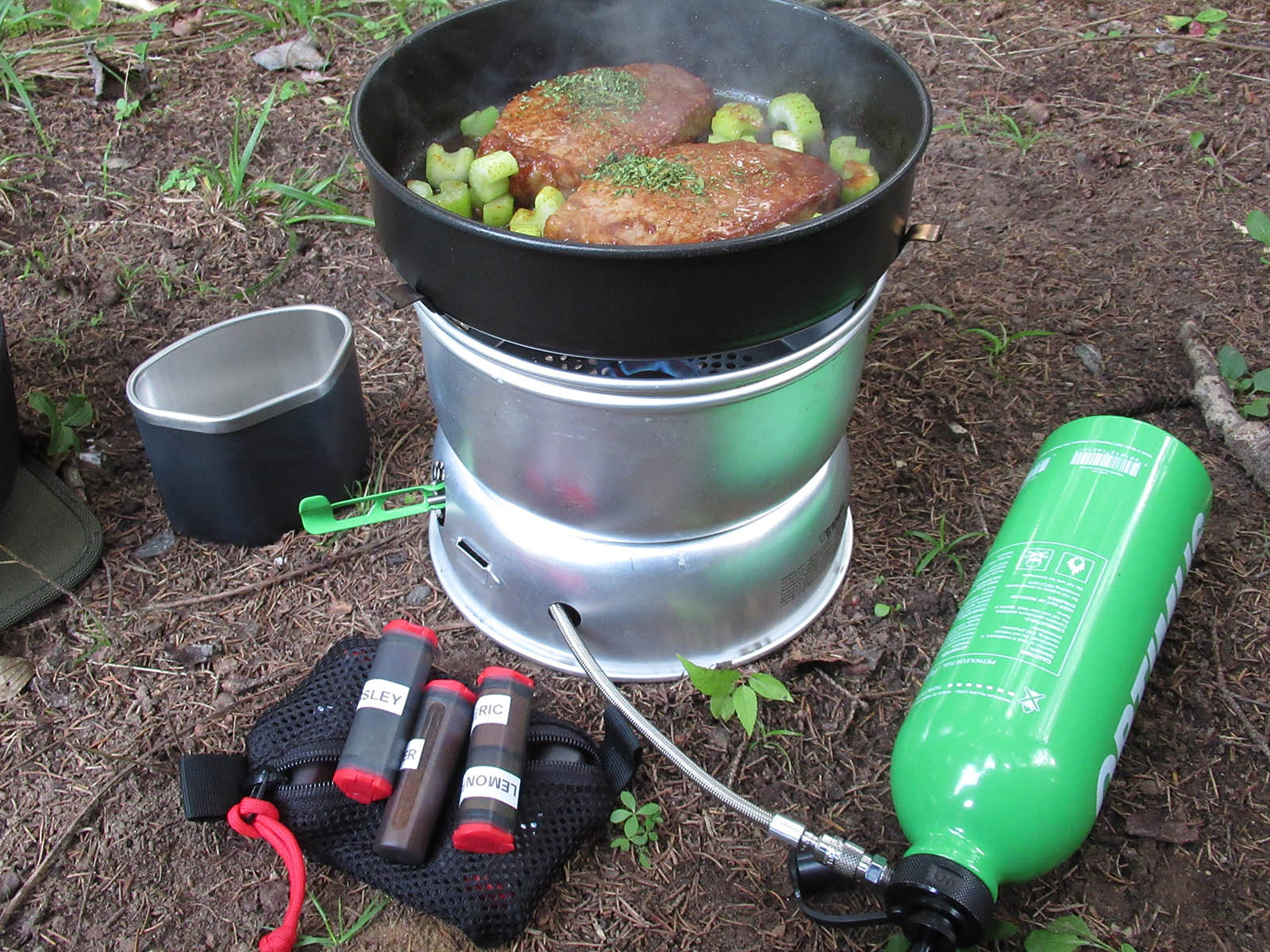
My Optimus Nova burner with the Optimus Stoves Trangia Adapter installed and dropped into the lower windscreen of the new Trangia 25 series set. Still going strong after all these years and pictured here helping to cook my supper during a power outage.
Fuel and Burner Options
With regards to the different types of fuel I have been referencing thus far, a summary follows below. Depending on your choice of fuel, different drop-in burner units are available. The Trangia set that was sent to me for review included both the spirit burner and the isobutane camping gas burner. Since my late 20’s I have used a 27 series Trangia set and purchased an Optimus Nova stove (probably around 2009) to have a secondary option.
The really cool thing I found with these Optimus stoves is that you can take the burner part out of the cylindrical pot support piece (tool is provided), put an Optimus Stoves Trangia Adapter on it and you have the option to burn white gas fuel inside your Trangia stove. That’s what I did back then and that stove is still going strong today so I also took it with me while testing out this new set.
These days however, you wouldn’t even need two different burners anymore if you want the option to use camping gas and white gas liquid fuel. The new Optimus Polaris Optifuel Stove does both without having to change a thing in your burner! It can go from propane, butane and isobutane canisters straight to petroleum based fuels like white gas, diesel, kerosene or jet fuel without you having to change jets or needles.
The amount of options available regarding fuel selection and Trangia stove compatibility is really impressive. The ability to use different types of fuel results in a highly multi-functional cooking set with solid four season performance capabilities in any environment and anywhere in the world. I really like this feature. Switching back and forth between those different fuel types is also easily accomplished by just changing out one burner unit for another. This can be motivated by the type of adventure, which country your in, the kind of fuel that’s readily available there, the terrain you’ll be traveling through and the environmental conditions you’re most likely going to encounter. The ability to easily change out burner units also means you don’t need to change your entire cooking kit composition because there a fire ban. Just switch to a isobutane gas or white gas burner and that’s it.
I have used 5 types of fuel since receiving the Trangia set:
1) Methyl Hydrate (aka methylated spirits)
- Solvable Methyl Hydrate
2) Camping Gas Canisters (Isobutane)
- Optimus
- MSR
- Jetboil
3) White Gas Liquid Fuel
- Coleman Petrolium Naptha fuel
- MSR SuperFuel White Gas
4) Solid Alcohol Fuel Tablets
- BCB Fire Dragon tablets
5) Starfit liquid fondue gel (aka denatured alcohol)
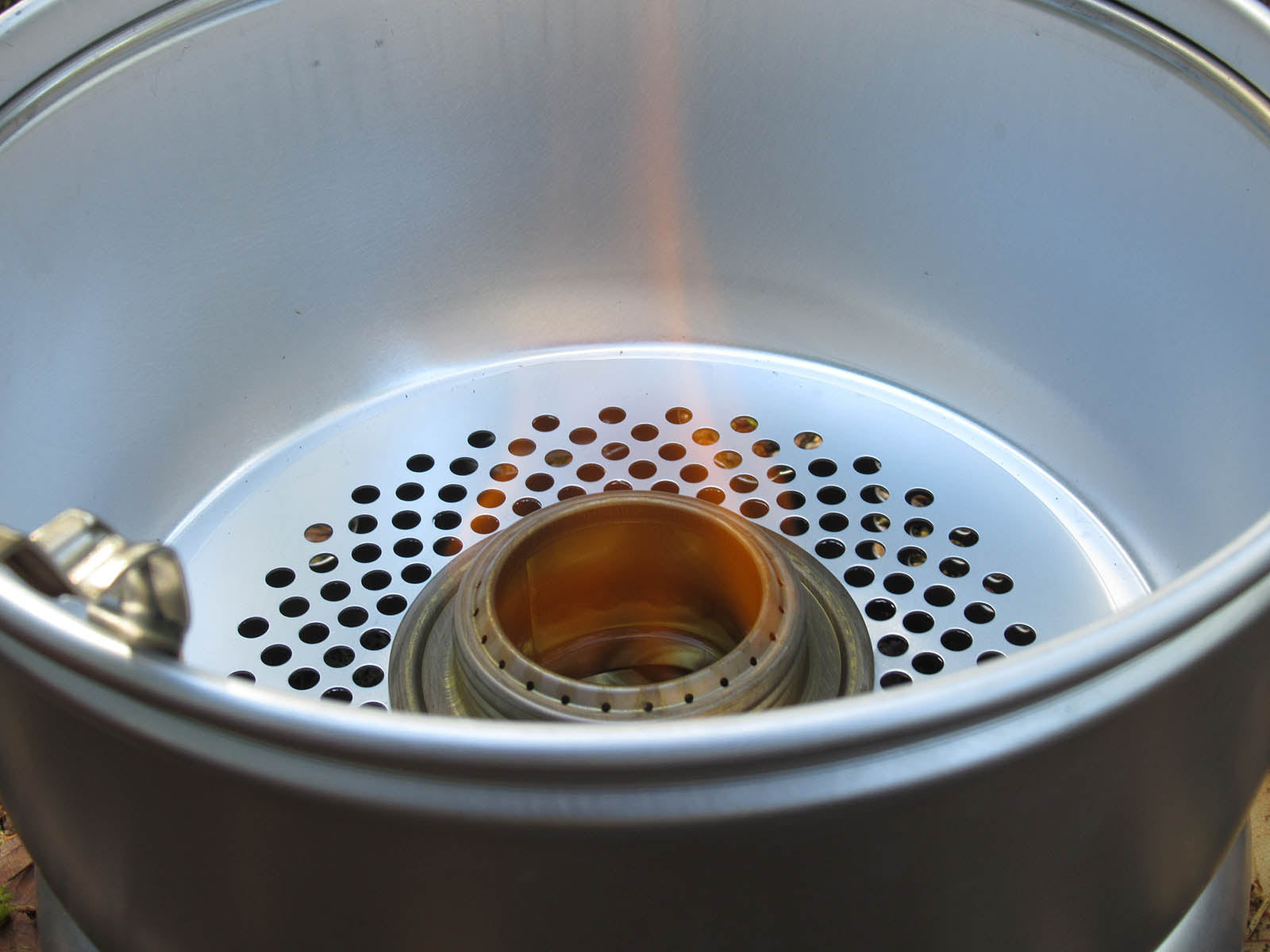
The Trangia brass alcohol burner is an uncomplicated, non-technical stove offering campers a dependable, clean and quiet option for outdoor cooking.
Using methylated spirit, also referred to as methyl hydrate, has been a proven option in outdoor cooking stoves for decades. Methylated spirit is a general purpose fuel alcohol made from methanol. It can be used as a solvent and as fuel in camping stoves like the Trangia brass burners. This type of fuel is inexpensive and readily available in hardware stores worldwide which is a bonus for international travelers deciding to use a Trangia cooking kit. The fuel doesn’t freeze, burns quietly and very cleanly - producing no smoke or soot.
The Trangia alcohol burner is really straight forward and easy to use; simply pour fuel into the reservoir and light it on fire. The burner unit itself is made from brass and consists of 3 parts: the actual burner, the simmer ring, and the lid with o-ring. Lacking any mechanical parts like a pump, valves, jets or internal o-rings, there is really no technical issue that can prevent the stove from working. There’s no wear and tear or the need for scheduled maintenance, check-ups and replacements. As long as you have fuel and an ignition source, you can cook or boil.
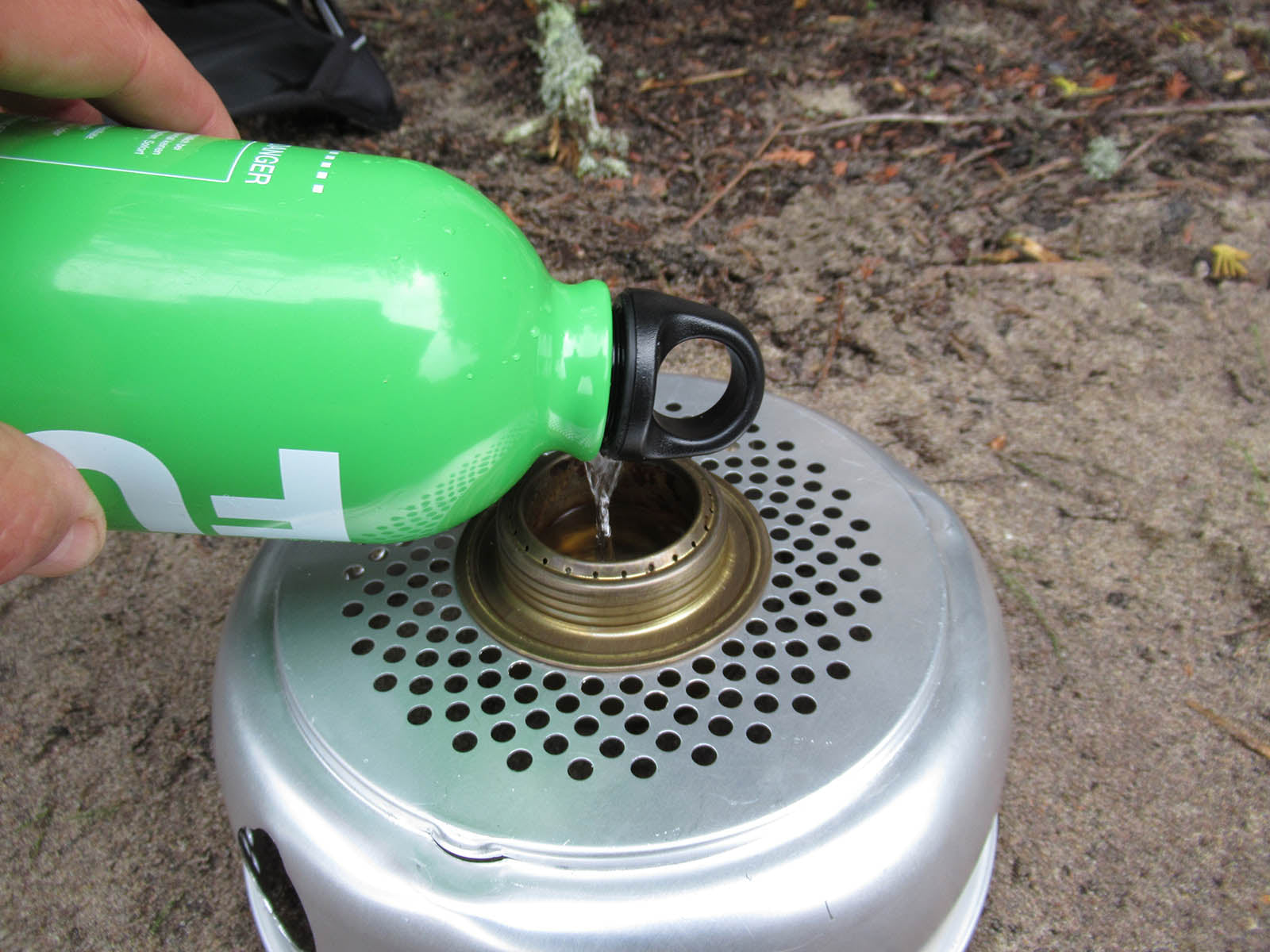
Trangia alcohol burners are straightforward and easy to use. Fill, light and start cooking.
Because the brass alcohol burner doesn’t require a pressurized fuel reservoir to operate, it burns incredibly quietly. Cooking or boiling over alcohol is a completely different experience in comparison to using either camping gas or white gas fuel. There’s no hissing or ‘jet engine’ noise you have to content with while preparing a meal in nature. Cooking on alcohol does have both benefits and drawbacks though. I guess it all depends on your personal preference and circumstances. The downside of not having a pressurized fuel canister with output regulator/shut-off valve is that your cooking times will increase and you need to get good at estimating how much fuel is needed to cook your food. It’s also a bit more finicky using the simmering ring to adjust the temperature output for foods that are prone to burning. However, all this is easily accomplished once you get some experience with the stove and the type of meals you’re cooking.
In the event you’re finished and the stove is still going, you can turn the simmer ring completely close and smother the flames. Let the burner cool down and put the screw lid on. Unused fuel can be stored in the burner cup while on a trip (as the screw lid is gasketed).
Even though a full alcohol burner will produce heat for a significant duration of time (30 - 40 minutes depending on temperature and elevation), it may not be sufficient if your food requires really long cooking times to get ready. A refill may be needed to fully cook your meal. The difference between a full reservoir of alcohol compared to the available amount of fuel in a camping gas canister or white gas fuel container is of course significant. This is easily overcome if you adjust your meal plan. I personally don’t bring foods that require long cooking times or prepare elaborate multi-course meals while hiking or canoeing. It takes too much time, effort and fuel. It also requires bigger food bags and way more garbage then I like to be hauling around on trips. I usually cook one pot meals but I also have kept things warm in one pot while cooking something complementary in another. I reheat both just before serving. If you plan and select your menu accordingly, you can significantly cut down on cooking times and still produce tasty meals while camping out with a Trangia.
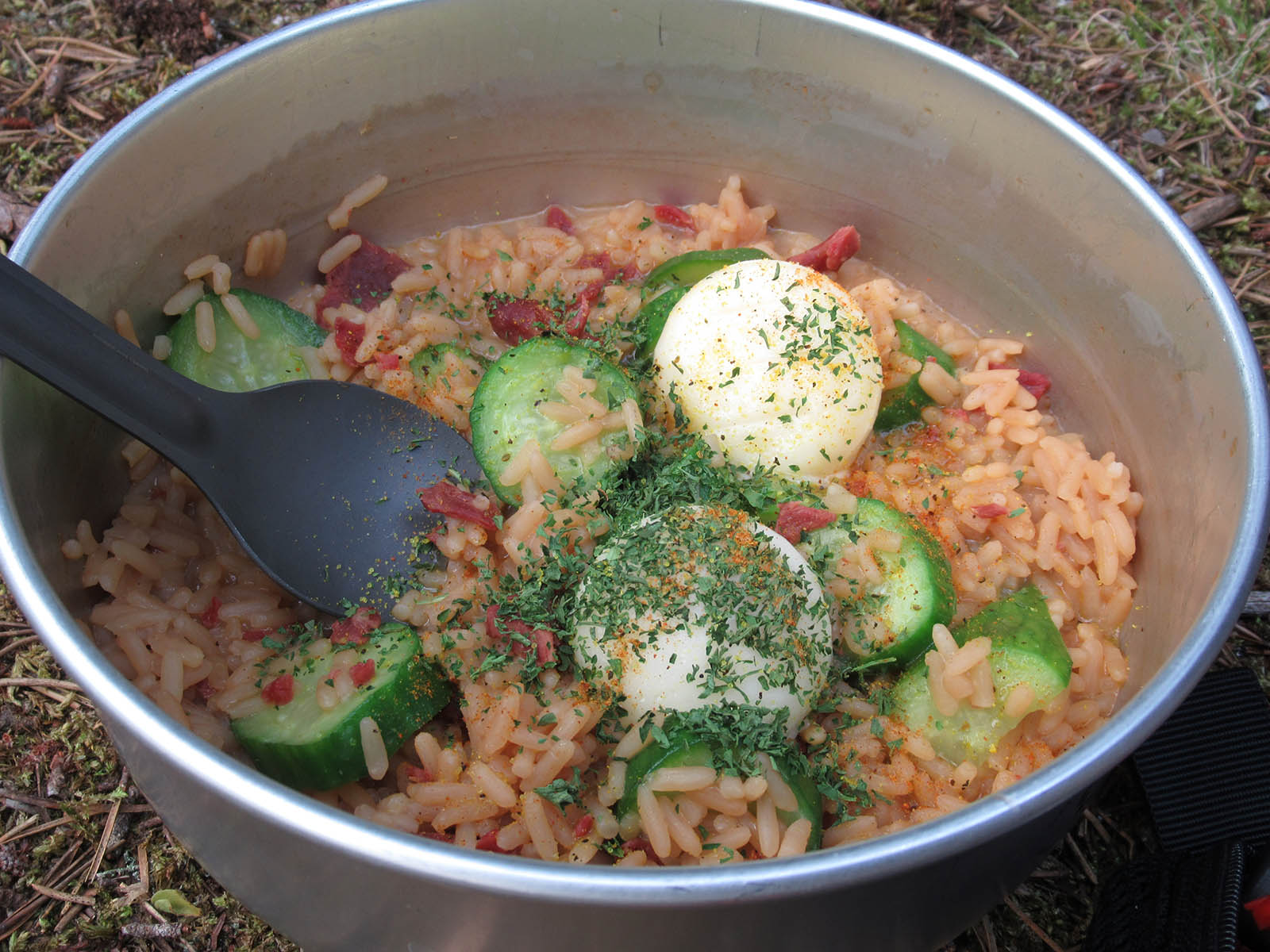
One pot meals are the way to go during my outings. This is a store bought instant rice package and I’ve added some beef jerky bits, a mini cucumber, two mini cheese wheels and some spices. Quick, super tasty and way cheaper compared to some alternatives.
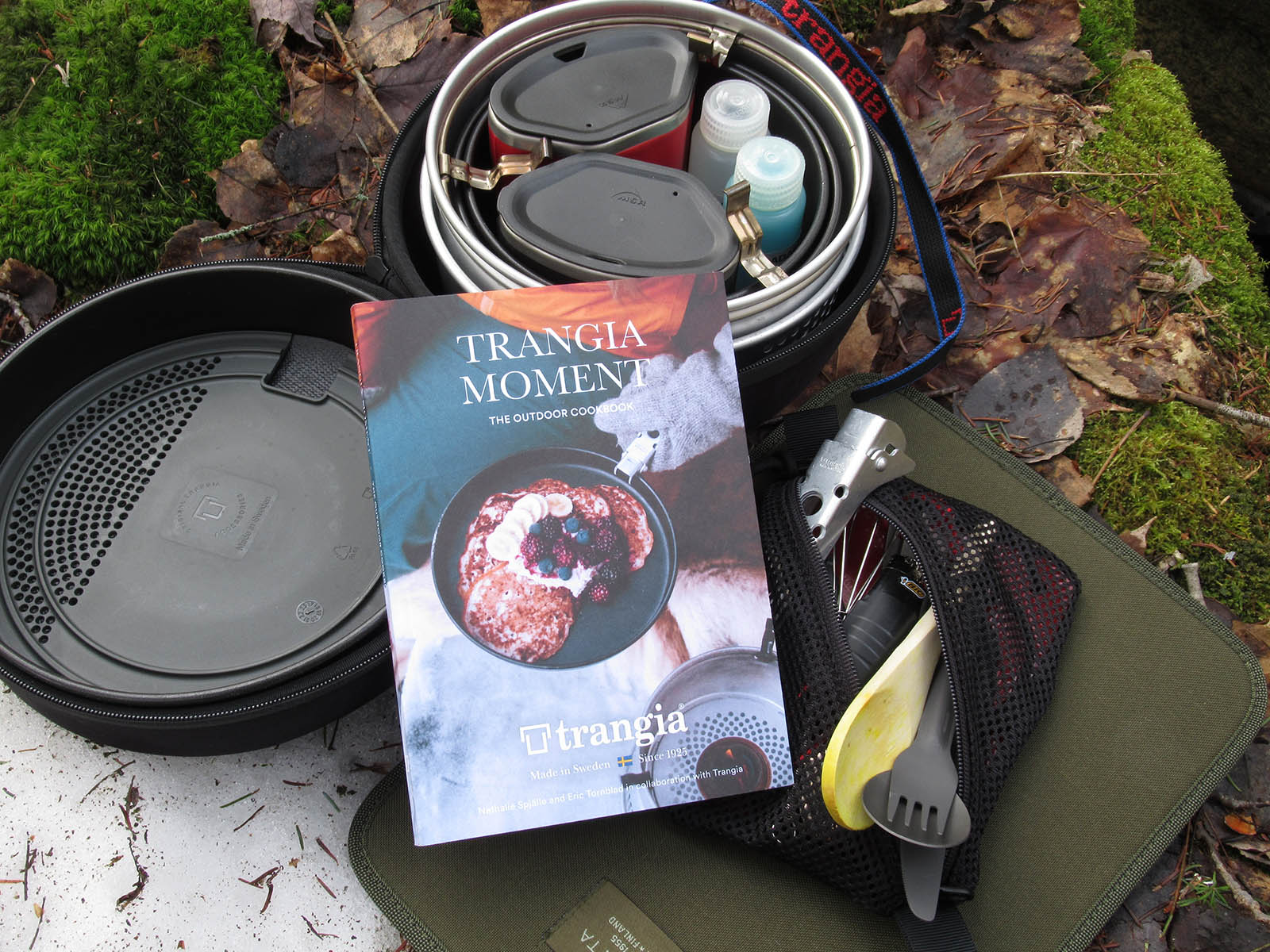
The Trangia moment’s outdoor cookbook. Skilled outdoor chefs share tips and tricks for amazing meals in the outdoors.
Benefits of Trangia Stoves
Another benefit of Trangia stoves, which is not often talked about, is the level of stability an assembled cook set offers the user. Gone are the days of needing to hold and balance a pot on a stove while stirring the food. Even when boiling water, one often needed to prevent the pot from moving off the 3 or 4 prong support when bubbles started to roll. More often than not, you were using two hands to keep everything balanced and going. With Trangia’s windscreen support system, that’s a thing of the past.
The ingeniously designed two piece windscreen assembles by twisting the upper onto the lower. The upper also fits into the lower, creating a compact and protective transport carrier for the two saucepans and other components. A wide circular aperture in the center of the lower windscreen is meant to fit one of the preferred drop-in burner units. When choosing not to use the alcohol burner, a smaller sidewall opening in the lower screen allows for an armored fuel line to exit and connect to either a camping gas canister or white gas fuel bottle. A second slightly bigger sidewall hole is meant to exit and access a white gas burner regulator/shut-off valve. The upper windscreen has 3 folding ams which, when folded down and in, securely hold one of the saucepans over the burner. When folded up and out, these 3arms securely hold the frying pan or, if purchased separately, a Trangia Billy pot. The low center of gravity when boiling water and cooking food in the saucepans, eliminates the need to physically hold that pot in place.
Cooking in this manner creates an extra level of safety for less experienced users, or when camping and cooking with kids or pets around. The risk of getting burned or scalded is significantly less with a Trangia stove versus having to cook while balancing a pot on top of a burner on top of a canister. These stoves offer a great opportunity to include children while cooking in the outdoors, without posing an elevated risk. The windscreen creates very good stability, helps protect hands from direct contact with an active burner and keeps the center of gravity low so stirring a cooking meal doesn’t require holding the pot with the other hand.
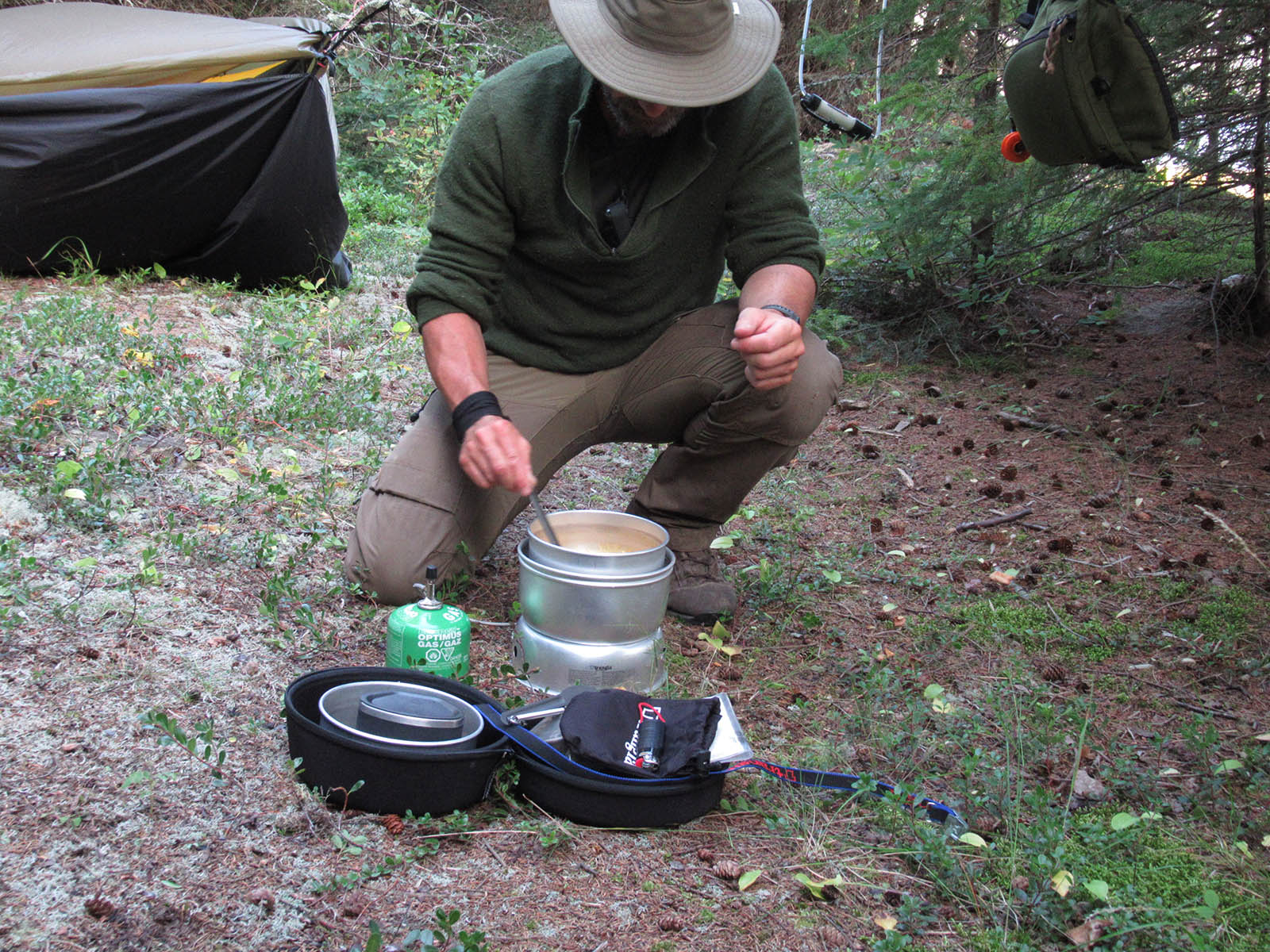
The level of stability offered by the 25 series windscreen increases user safety, wind protection (without flimsy screens) and heat retention. Although a little heavier then other set ups, I find it far more relaxing to cook this way.
Using your Trangia stove system in colder temperatures is also no problem. All 4 of my drop-in burner units have been used in winter environments without any issues.
1) The spirit burner uses alcohol fuel which doesn’t freeze, but is slow to get going in real cold temperatures. Trangia came out with a Winter Attachment Kit to improve performance. This burner preheat system attaches to the bottom of the brass unit and also has a ‘dish’ that fits under the bottom windscreen, minimizing heat-loss with the snow/ice and preventing snow from reaching the burner. Not absolutely necessarily but it does increase burn efficiency in cold weather.
2) The Trangia camping gas burner in itself has no specific winter upgrades but some manufacturers will offer camping gas canisters specific for cold temperature use, referred to as winter gas. It’s also handy to learn how to keep your gas canister from getting too cold/freezing while in use. This goes a long way if you want to use camping gas efficiently in cold weather. The FlipFuel Isobutane Transfer device allows you to consolidate your collection of partially used canisters into one or several full canister. This little device is well worth the investment if you like cooking with camping gas.
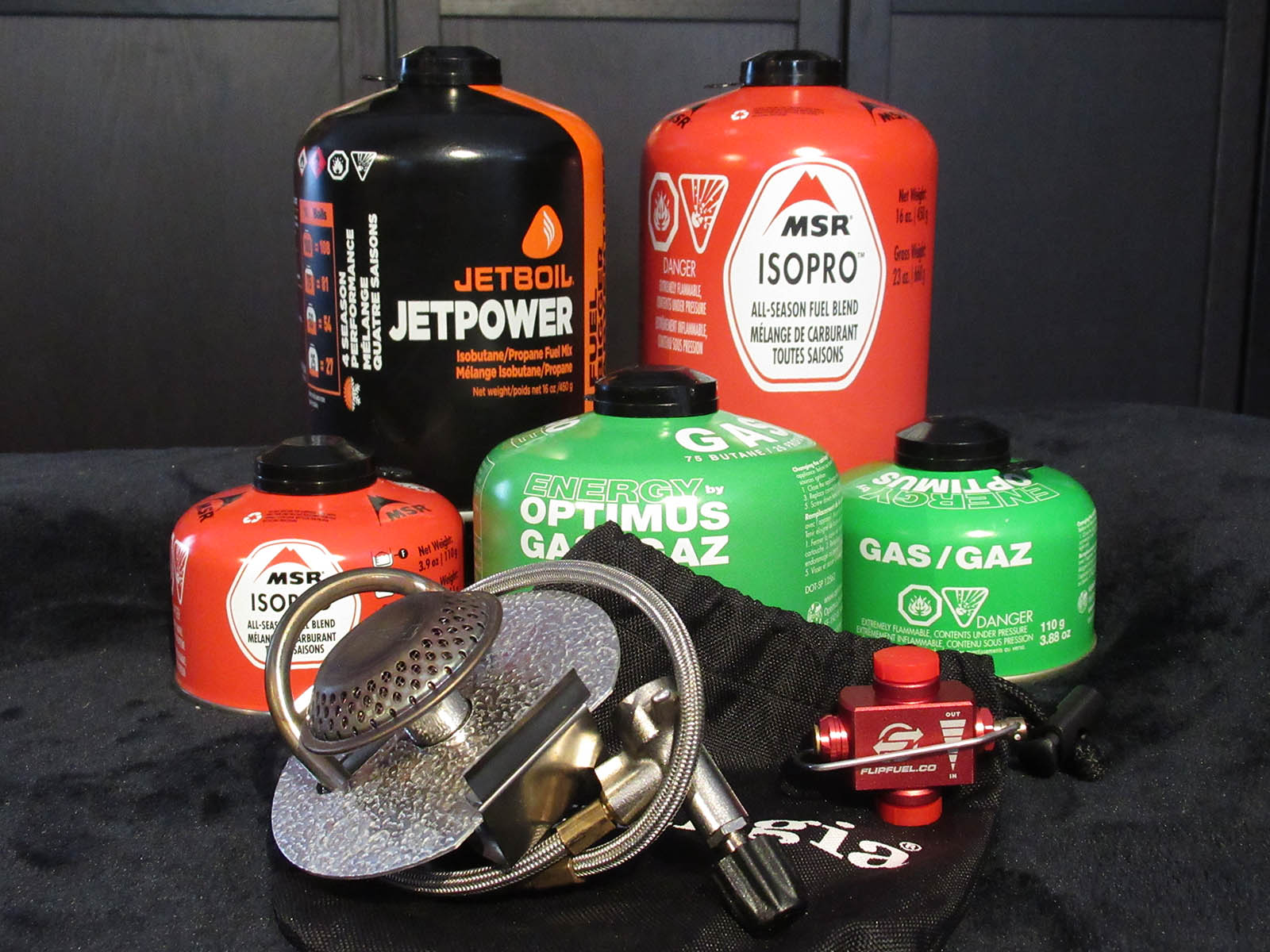
Trangia gas burner unit and some canister options with the FlipFuel Isobutane Transfer device pictured on the right
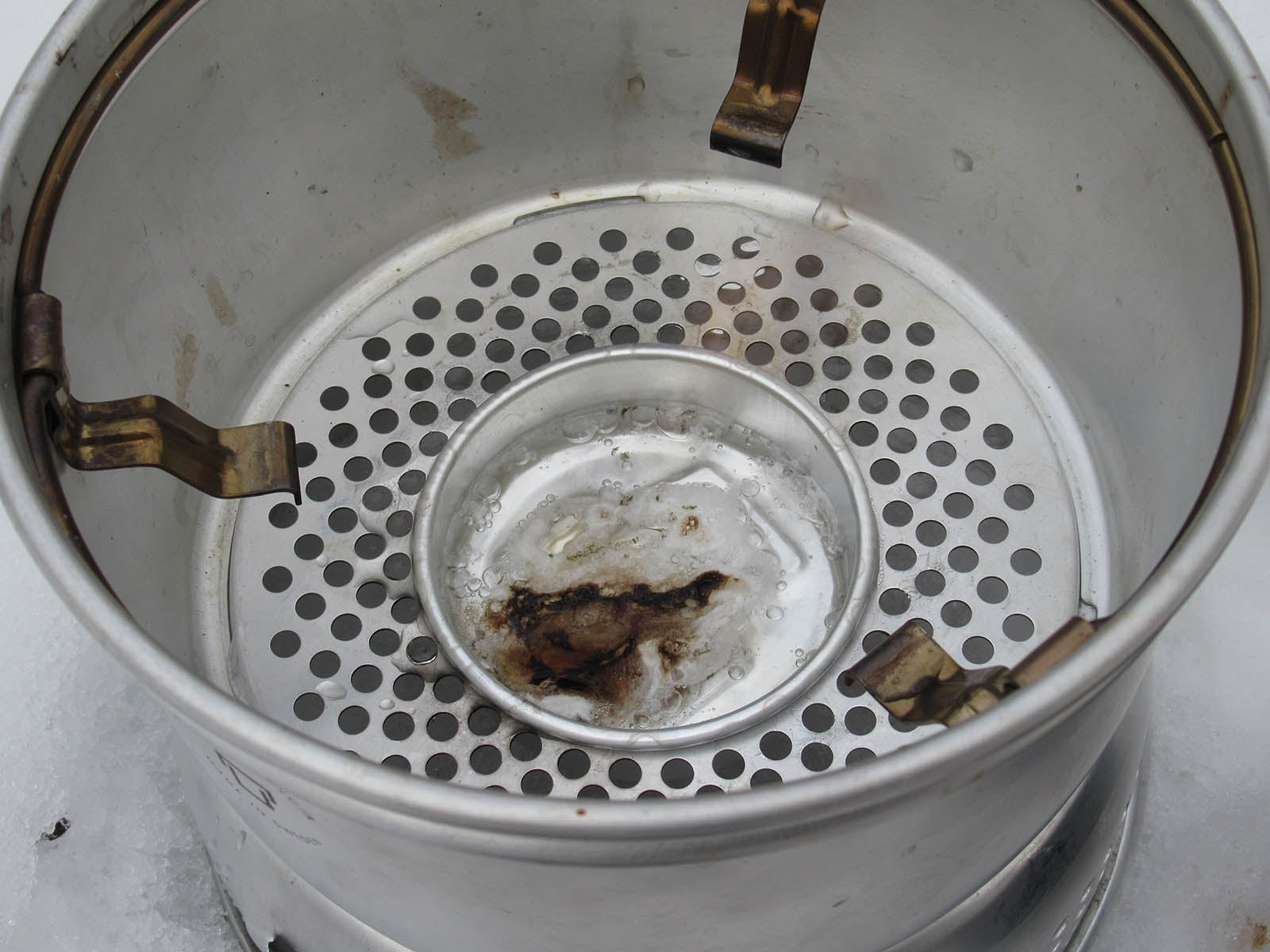
My Trangia Fuel Gel burner in action while dropped into my 27 series Trangia cooker. Although this is an option in winter, it’s not ideal. It does take a significant amount of gel fuel to melt, boil or cook like this during the colder months of the year.
3) Using a white gas fuel burner is probably your best and most fuel/time efficient option when melting, boiling or cooking in extreme cold temperatures. My Optimus Nova with Trangia adapter has never let me down in all those years.
4) The Trangia Gel Fuel Burner unit can also be used in winter. Solid alcohol fuel tablets and Starfrit fondue gel worked fine but it does require multiple tablets or a good amount of gel to melt, boil or cook in cold conditions. Not really fuel efficient but an option non the less. I prefer to use the gel/tablet burner option indoors (during power outages) in the event camping gas or white gas is not available. Much safer in case of an accidental spill compared to a liquid filled alcohol burner - so great when working with kids or scout groups.
Trangia Cooksets and Safety
Following below are some safety considerations and my personal recommendations specific to Trangia stoves, drop-in burner units, types of fuel and the use of camping stoves in general. Trangia cooking sets are safe, easy and straightforward to use but some aspects do require attentiveness and care to prevent misuse or accidents.
1) Make sure never to mix different fuels. Always use up what you have first, even if that means you have to stop cooking midway through and refuel the brass alcohol burner. When topping up or consolidating half empty bottles, make sure not to mix two different types of fuel.
2) Never put additional fuel into the brass alcohol burner when it’s burning, or when it just went out but is still very hot - stop cooking and wait a minute or two. Check with your hand for heat (as alcohol can burn with an invisible flame) and only refill when you've established the burner is not burning. Avoid spilling fuel when filling the burner. In case you do spill fuel, be patient and let evaporation take care of it. Move the unit to a different spot before lighting.
3) Never mistakenly use highly volatile white gas fuel (Coleman Naptha fuel, MSR SuperFuel and other similar fuels) in the brass alcohol burner - this can burn the internal wick and ruin the burner. Make sure you mark your fuel transport bottles for the field correctly and according to their content. This is especially important when using different fuels on the same trip, or if multiple people are using different set-ups and fuels in camp.
4) Be cautious when lighting methyl hydrate (alcohol) in the open top brass burner unit. Use a (long neck) BBQ lighter or matches and make sure you have a solid, stable base or mostly level underground to rest the stove on, prior to starting. The initial flame is pretty much invisible, especially in cold or daytime conditions. Carefully check ignition by waving your hand back and forth across the burner or bring your hand down from well above until you feel heat rising. Pay attention to long grasses or burnable materials when you put the unit on the ground. The winter attachment ‘dish’ can also be used to keep vegetation out when put underneath the windscreen.
5) Do yourself a huge favour and carry quality liquid fuel bottles in a sturdy, thick walled dry bag in the field. A couple of correctly sized spare o-rings are also not a bad idea, even after you checked those for defects prior to a trip. A leaking bottle will put highly flammable and poisonous fuel into your gear and you also lose part of your fuel supply.
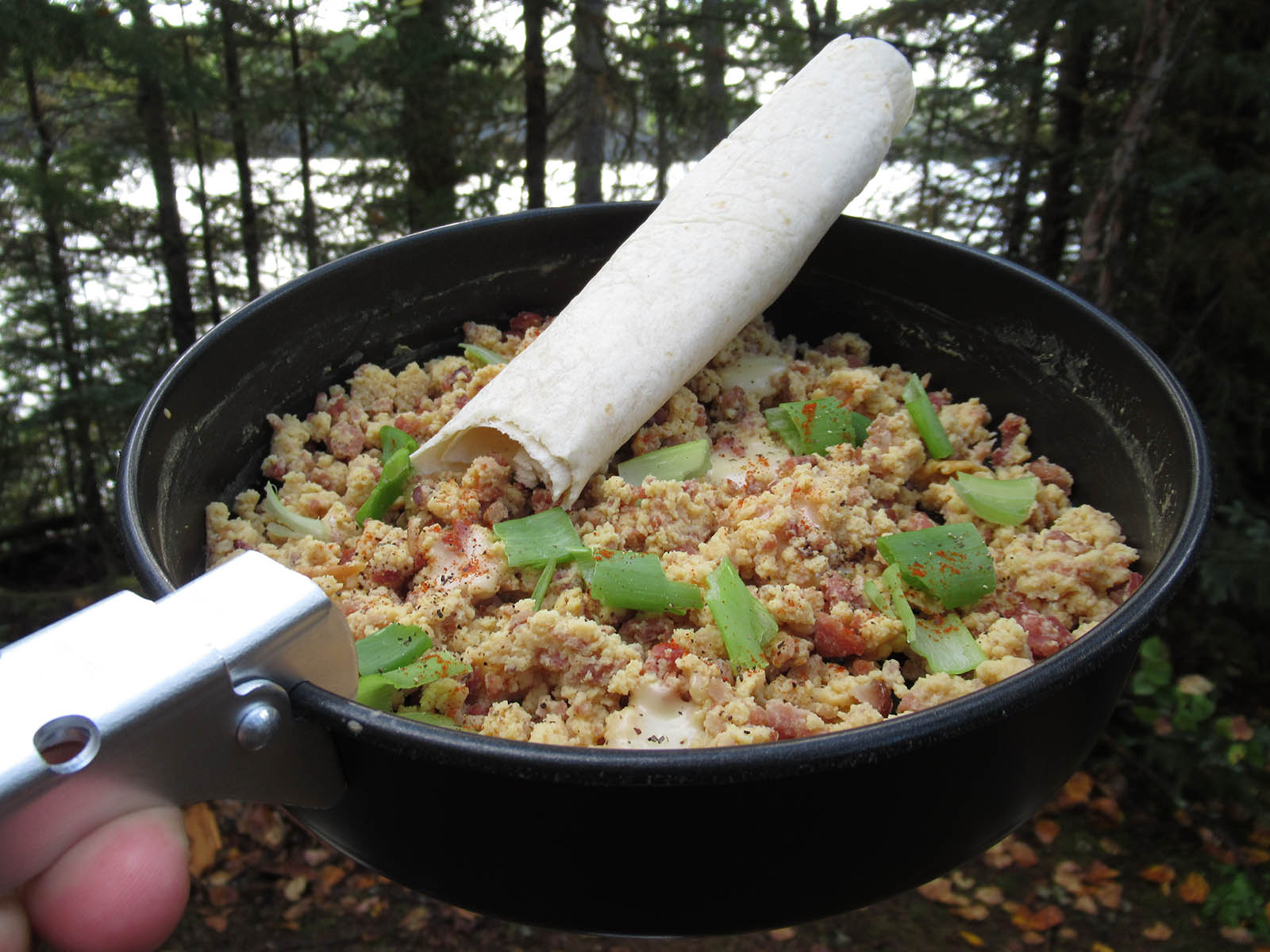
Favorite breakfast in the wild: bacon bits with powdered egg, celery, cheese and a wrap.
6) Avoid spilling fuel and always firmly close your fuel bottles after use. Best practice also includes keeping these bottles far away from fire, direct sunlight, kids and pets. In a camp were people are moving around, kids are playing or animals are of lead, establish a safe space or barrier to prevent the bumping or toppling of a burning stove and its hot content.
7) Always check if the regulator/shut-off valves on both camping gas and white gas drop-in burners are closed before connecting them to a camping gas canister or white gas fuel bottle. Only when you are immediately ready to light or preheat, should you turn the regulator valve modestly open. Keep these units in top condition, perform regular function checks and keep up with the maintenance. Because these fuel containers are pressurized, a leaking o-ring or damaged fuel line can automatically put out a large amount of fuel into the burner unit or surrounding area. Such a malfunction will have very dangerous consequences if unnoticed prior to lighting the burner. Bring a repair kit.
8) Be very careful when deciding to use camping stoves indoors, be it in the opened vestibule of a tent (bad weather, arctic, alpine environments) or inside a house during power outages. With regard to tent vestibules, position the stove on a flat stable surface, close to the exit. Fire the stove up outside, then bring it in. Leaked fuel due to damage or too much fuel released for preheating purposes can produce a huge fire ball when lid: a bad idea in a low ceiling nylon tent. When using the alcohol burner indoors, make sure you are using de-natured alcohol (ethanol based fuels) with adequate ventilation, and realize you are dealing with an open top container filled with highly flammable liquid fuel. Bumping or manipulating the burner in tight spaces and unintentionally spilling fuel mid-burn should definitely be avoided.
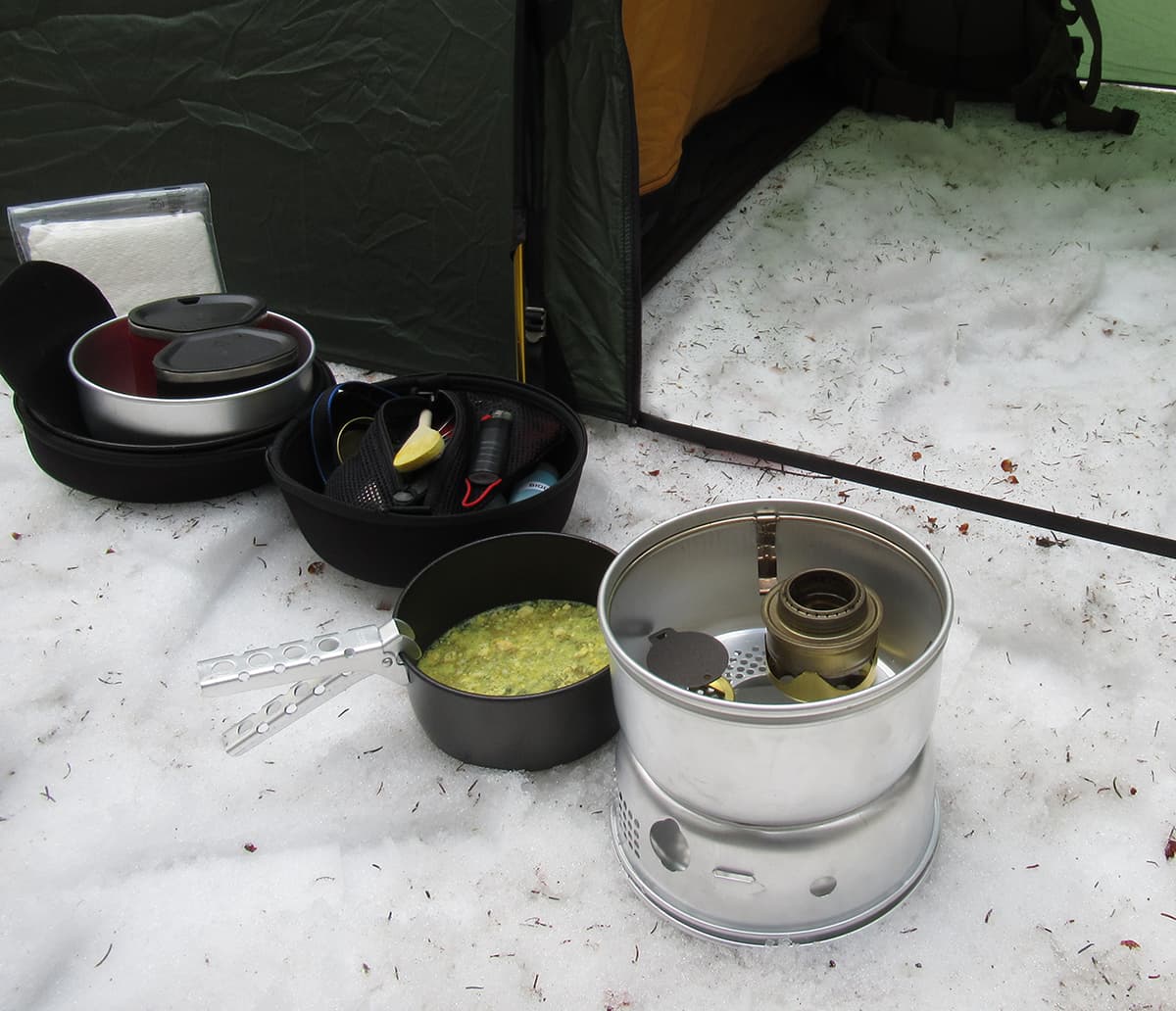
Getting ready to fire up the Trangia in cold weather with the Winter Attachment Kit. The burner gets preheated and the ‘dish’ underneath the bottom windshield prevents extra heat-loss and helps to keep the unit from sinking deeper into the snow as it warms the food.
9) Educate yourself with regard to using camping stoves at altitude if applicable. Understand the interaction between your stove and the oxygen level, air pressure and boiling temperature. Learn why there is a heightened risk of carbon monoxide poisoning and the effects of altitude on piezo igniters, should you be using one on a stove.
10) Outfit your wilderness first aid kit with adequate burn and scald response gear and get trained. Bringing along an Outdoor Medical Emergency Handbook as reference guide is always worth the extra weight on (longer) outings.
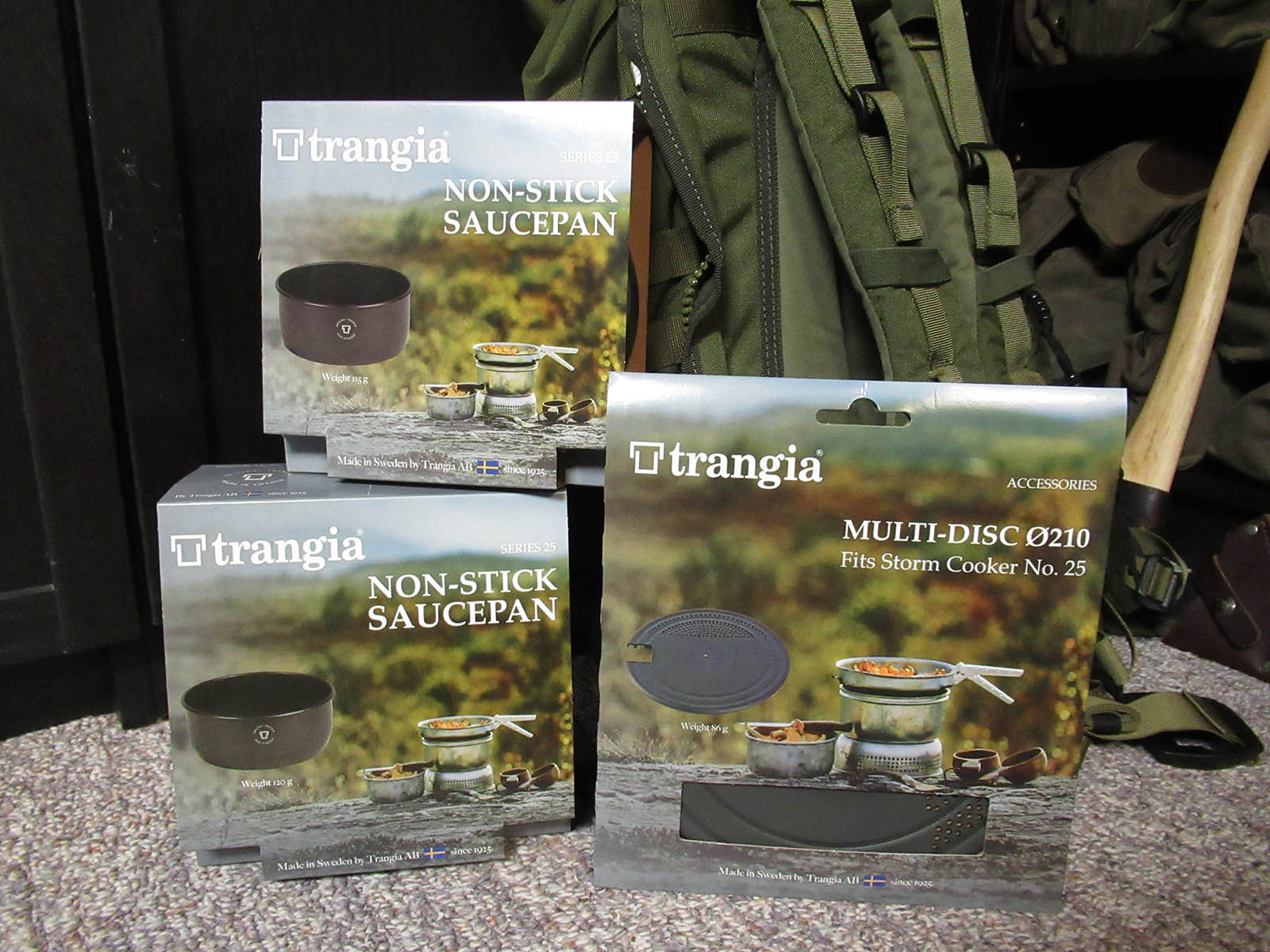
My upgrades for the new 25 series Trangia, inner and outer saucepans in NS Teflon coated and a 22 cm Trangia Multi disk.
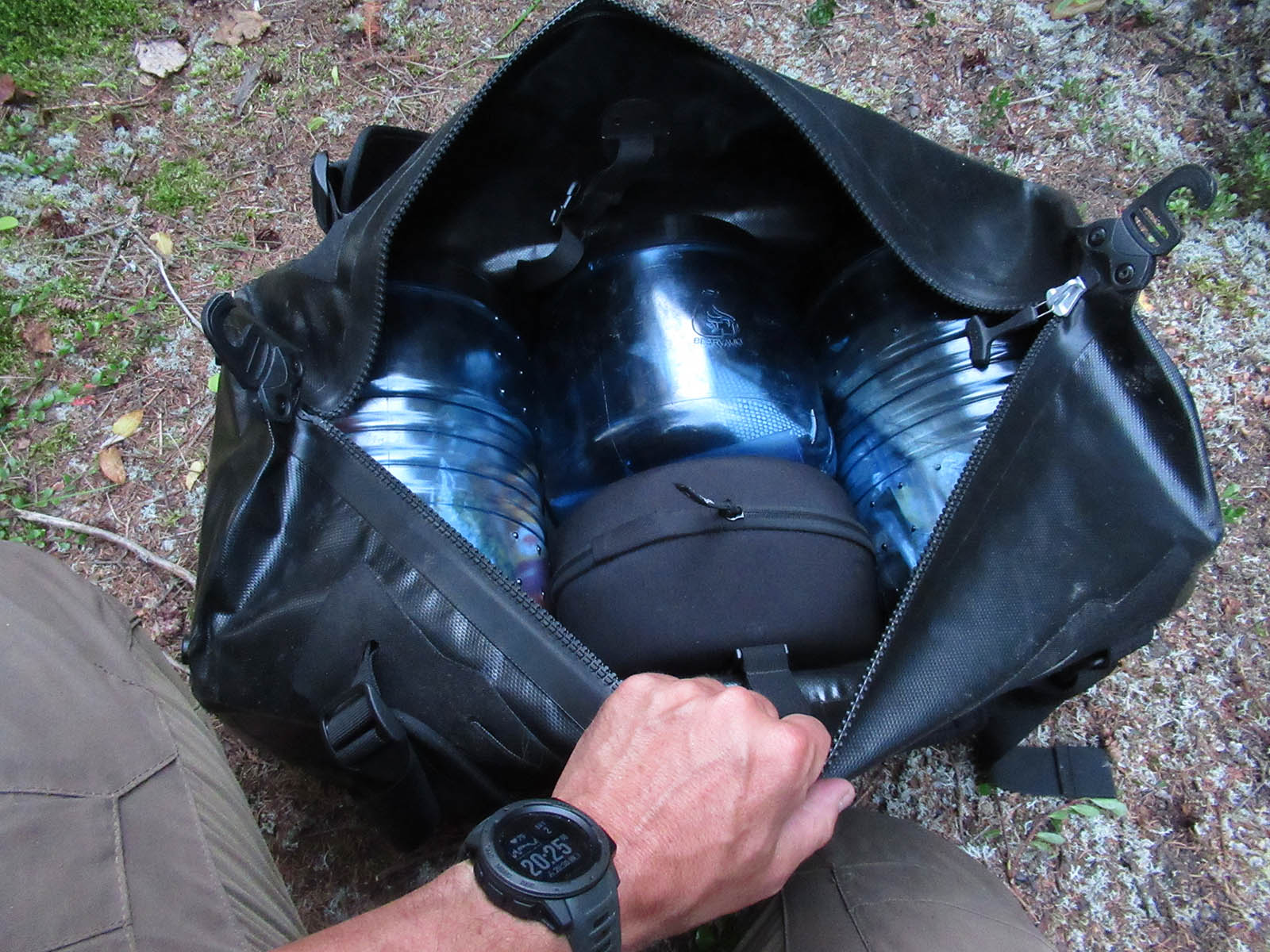
My 25 series “all in one” cook set protected in transport by the EVA carrying case. Big fan of this piece of equipment to keep everything secure and organized. The EVA pouch fitted perfectly along my bear proof food canisters during a 2 week river trip.
As mentioned, Trangia has a number of upgrades and additional items to complete your cook set. I changed out the UL Aluminum pots to NS Teflon coated pots. Although you need to be a little more careful when using metal utensils in those, (better even to use a wooden spoon) they clean up really easy in the field. I always take paper towel with me and by using just a little water or hand sanitizer, you can clean these pots and the pan without having to do dishes in case you don’t have a lot of water at your disposal.
If I want both options of cooking on an open fire and carrying a Trangia burner unit as back up, I’ll change out my biggest 1.75 litre NS Teflon coated pot for the UL Aluminum one. I can cook over a campfire with the UL pot, which is cheaper compared to the NS pot, and won’t be easily damaged scrubbing it clean when covered in soot.
I got a Trangia Multi Disc to be used as lid, strainer and cutting board. I am also a big fan of using the Trangia EVA Carrying Cases to keep my cook sets protected in transport. In addition, it also holds any unused cook gear of the ground while preparing my meal. The clamshell design works really well for this.
Conclusions
I really like this Trangia 25 series cook set. I enjoy the fact that I have the option to cook and boil silently in nature. Its also reassuring to know this stove will never have technical issues while cooking on alcohol. As long as I have fuel, it’ll work. With this in mind, I happily adjust my meal plans to accommodate for any imperfections associated with this type of cooking. Yes, camping gas and white gas are faster in comparison to alcohol and yes, it may be heavier then the ultra light camping stoves out there but to me personally, that little extra weight gives me a lot of extra comfort and peace of mind. If I need or want to use a different type of fuel, I’ll just change out one burner for another and that’s it. Super simple.
If there’s one negative aspect about the Trangia stove, it would be the stiffness of the simmer ring lid. I tried manipulating it sightly with a multi- tool in an effort to get it to rotate more easily when in use, but that had only limited success. Still contemplating a better solution for this.
It can become quite the task learning about options and selecting your ideal and preferred set up but Trangia has an excellent page on their website with 8 comprehensive categories to learn from. Tim Foley also has made a highly informative VLOG video covering the subject of fuel selection for Trangia stoves. Here are the links:
Choosing the right Trangia stove
Fuels for Trangia stoves in Canada
Trangia offers very durable cooking sets featuring a level of versatility and adaptability to the environment and your personal preference that is very unique compared to other brands of outdoor cooking stoves. I’m convinced Trangia can provide the interested outdoor enthusiasts and their family with a generational cooking set and many tasty meals while exploring the natural word together.
Shop The Gear
Peter Desmet
- Trangia Cooksets
- Trangia 25 Series Cooksets
- Trangia 27 Series Cooksets
- Trangia Cookware
- Trangia Accessories
- Fuel Containers
- Billy Tins/Billy Cans
- Trangia Burners
- Optimus Stoves
- Trangia Cooksets
- Trangia Replacement Parts
- 25 Series Cooksets
- 27 Series Cooksets
- Trangia 25-UL
- Trangia 25-HA
- Trangia 25 Duossal
- Trangia 25 Non-Stick
- Trangia 27-UL
- Trangia 27-HA
- Trangia 27 Duossal
- Trangia 27 Non-Stick
- Gifts for Family Campers
- Gifts for Backcountry Campers










